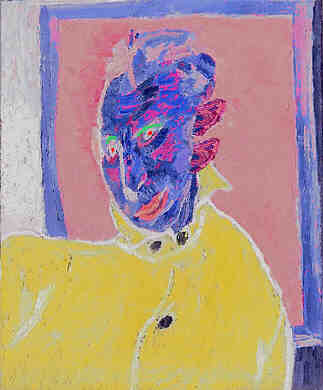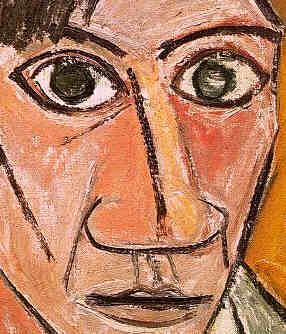^
Born on 24 June 1883: Jean
Metzinger, French Cubist
painter, critic, and poet, who died on 03 November 1956. He came from a
military family, but, following the early death of his father, he pursued
his own interests in mathematics, music and painting. By 1900 he was a student
at the Académie des Beaux-Arts in Nantes, where he worked under the portrait
painter Hippolyte Touront. After sending three pictures to the Salon des
Indépendants in 1903, he moved to Paris with the proceeds from their sale.
Thus, from the age of 20, Metzinger supported himself as a professional
painter, a fact that may account for some of the shifts to which his art
submitted in later years. He exhibited regularly in Paris from 1903, taking
part in 1904 in a group show with Touront and Raoul Dufy at the gallery
run by Berthe Weill and also participating in the Salon d’Automne in that
year. By 1906 he had enough prestige to be elected to the hanging committee
of the Salon des Indépendants. By the time he began dating his works around
1905 he was an ardent participant in the Neo-Impressionist revival led by
Henri Edmond Cross. He also formed a close friendship at this time with
Robert Delaunay, with whom he shared an exhibition at Berthe Weill early
in 1907. The two of them were singled out by one critic in 1907 as divisionists
who used large, mosaic-like ‘cubes’ to construct small but highly symbolic
compositions. — Metzinger's students included Serge Charchoune, Jessica
Dismorr, Lyubov’ Popova, Nadezhda Udal’tsova.
— LINKS
— Still
Life (72x99; 846x1200pix, 89kb — ZOOM
to 1411x2000pix; 260kb) _ could have been named La table du déjeuner
au café.
— Cubist
Composition, Still Life (1918)
— Landscape
(1904, 380x462pix, 193kb) _ This early landscape by Metzinger shows his
roots in Fauvism. Inscribed on the reverse of the canvas is the date 1904,
indicating that it was painted soon after Metzinger's arrival in Paris,
at the height of the Fauvist movement led by Matisse. Fauve painting is
characterized by brilliant color and simplified forms, celebrating emotions
inspired by nature, as opposed to the imitation of nature. Metzinger once
described Fauvist painting as "taking our hint from Nature, to construct
decoratively pleasing harmonies and symphonies expressive of our sentiment."
In this landscape, the vibrant color patches are far from naturalistic,
depicting instead the exuberance inspired in the artist by the scene. The
short, broad brushstrokes add a rhythmic pattern to the canvas, energizing
the negative spaces as well as the solid forms. The result transforms notions
of time and space to show intensity, radiance, and joy in the experience
of nature.
— Scène
du port (1912, 54 x 46 cm) _ The greatest liberating pictorial style
of the twentieth century was the Cubism developed by Picasso and Braque
in the first years of the century. For some artists, it led to abstraction;
for others, it was merely a style to be adapted to pre-existing approaches
to picture making. For Metzinger, Cubism was a system by which multiple
perspectives could be juxtaposed on a single plane; his almost monochromatic
palette meant that the viewer is not distracted from the study of perspective.
Metzinger was an early proponent of Cubism and wrote some of the first important
theoretical essays on it. On Cubism, written in 1912 with his fellow Cubist
Albert Gleizes, was the first theoretical work devoted to the new movement
and played a major role in its recognition. Metzinger himself often experimented
with Cubist techniques, but his work differs from other Cubists in that
his paintings retain a recognizable scene, here a landscape, a fairly rare
subject for the early Cubists, with a system of mathematically calculated
proportions, planes, and angles superimposed on it, like a grid. In the
works of Picasso and Braque, small rectangular planes first go above, then
below, then simply fade into other planes; Metzinger reduced his recognizable
subjects into a series of rationally calculated and plotted planes, each
laid over the other,as they move back in depth.
— Au
Vélodrome (1914, 130x97cm; 573x429pix; 118kb) _ Jean Metzinger,
a sensitive and intelligent theoretician of Cubism [more], sought to communicate
the principles of this movement through his paintings as well as his writings.
Devices of Cubism and Futurism [more] appear in At the Cycle-Race Track,
though they are superimposed on an image that is essentially naturalistic.
Cubist elements include printed-paper collage, the incorporation of a granular
surface, and the use of transparent planes to define space. The choice of
a subject in motion, the suggestion of velocity, and the fusing of forms
find parallels in Futurist painting. Though these devices are handled with
some awkwardness and the influence of Impressionism [more] persists, particularly
in the use of dots of color to represent the crowd in the background, this
work represents Metzinger’s attempt to come to terms with a new pictorial
language. Lucy Flint. |
 ^
Died on 24 June 1964: Stuart
Davis [click image for self~portrait >],
US Abstract painter born on 07 December 1894.
^
Died on 24 June 1964: Stuart
Davis [click image for self~portrait >],
US Abstract painter born on 07 December 1894. 